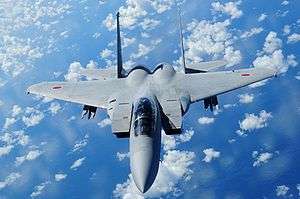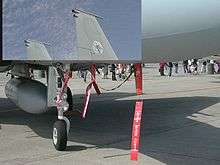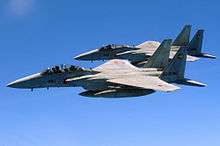Mitsubishi F-15J
| F-15J Eagle | |
|---|---|
 | |
| A Japan Air Self Defense Force F-15DJ in flight. | |
| Role | Air superiority fighter |
| Manufacturer | Mitsubishi Heavy Industries, McDonnell Douglas |
| First flight | 4 June 1980 |
| Introduction | 7 December 1981 |
| Primary user | Japan Air Self-Defense Force |
| Number built | 223 |
| Developed from | McDonnell Douglas F-15 Eagle |
The Mitsubishi F-15J/DJ Eagle is a twin-engine, all-weather air superiority fighter based on the McDonnell Douglas F-15 Eagle in use by the Japan Air Self-Defense Force (JASDF). The F-15J was produced under license by Mitsubishi Heavy Industries. The subsequent F-15DJ and F-15J Kai variants were also produced. Japan is the largest customer of the F-15 Eagle outside the United States.[1] In addition to combat, F-15DJ roles include training. The F-15J Kai is a modernized version of the F-15J.
Development
In June–July 1975, the Japan Defense Agency (JDA, now Ministry of Defense) examined the McDonnell Douglas F-15 Eagle as one of the 13 candidates for the replacement of the F-104J/DJ Starfighter and F-4EJ Phantom II. A single-seat F-15C and a twin-seat F-15D were evaluated at Edwards Air Force Base, and in December 1975, the F-15 was announced the winner, with the government intending to purchase 187 F-15J/DJs. By April 1978, Mitsubishi Heavy Industries was designated as the primary contractor and licensing for the F-15C/D was achieved.[2][3]
After congressional review, the Department of Defense (DoD) withheld the aircraft's electronic warfare and engine systems from the licensing. Initially, the aircraft were produced in the U.S. and exported to Japan. This initial export production contributed to aircraft development under the defense industry of Japan while facilitating base production of aircraft, achieving the goal of producing a fighter to Japan's requirements.[4]
The Japan Air Self-Defense Force (JASDF) acquired 203 F-15Js and 20 F-15DJs, of which 2 F-15Js and 12 F-15DJs were built by McDonnell Douglas in St. Louis, Missouri.[2] Dubbed the "Peace Eagle" by the DoD FMS program, the first F-15J built in St. Louis was delivered to the United States Air Force for its first flight on 4 June 1980, and a subsequent cruise on 15 July to Japan. Additionally, 8 F-15Js were manufactured in large components and shipped to Japan for final assembly by Komaki of Mitsubishi, the first of these (serial number 12–8803) making its maiden flight on 26 August 1981.[2][5] Companies divided the remainder share and produced it under license from 1981, with final assembly of aircraft performed by Mitsubishi.[2]
In 1980, the Japanese government applied for access to advanced technology through the U.S.-Japan Forum (S&TF) but this was rejected. The JDA and the DoD held annual meetings about relaxation of the regulation after a program was started. In these meetings, the DoD official gave an answer that permitted access to initially prohibited technology of various types including composite material.[6]
In the latter period of 1981, the first F-15J/DJ aircraft were sent to 202 Squadron, which was reorganized as an Eagle FTU and renamed the 23 Flying Training Squadron at Nyutabaru base on 21 December 1982. The JASDF developed a plan to form the first squadron after the KAL007 shootdown by a Soviet Su-15 on 1 September 1983. In March 1984, new F-15Js began replacing the 203 Squadron's F-104Js at Chitose Air Base, located across the La Pérouse Strait from the Soviet fighter base on Sakhalin Island.[2][7]
Design

F-15J/DJs are identical to F-15C/Ds aside from the ECM, radar warning system, and nuclear equipment. The AN/ALQ-135 Internal Countermeasures System is replaced by the indigenous J/ALQ-8 and the AN/ALR-56 Radar Warning Receiver is replaced by the J/APR-4. The engine is the Pratt & Whitney F100 turbofan, produced under license by IHI Corporation. Some aircraft still have an inertial measurement unit, an old type of the Inertial navigation system. All F-15J/DJs have two UHF radios, which are also VHF capable.[8]
The F-15J is characterized by an indigenous data link, but they do not support Link 16 FDL mounted by USAF F-15Cs. It works as a basic bidirectional link with the Japanese ground-controlled intercept network, and it is limited because it is not a true network.[8]
Mitsubishi received the F-15C/D Multistage Improvement Program (MSIP) and in 1987 began upgrading the F-15J/DJs. Improvements included an uprated central computer, engines, armament control set and added the J/APQ-1 countermeasures set.[9][10] The F100-PW-220 (IHI-220) was upgraded to the F100-PW-220E (IHI-220E) with a digital engine electronic control retrofit.[11] Differences in appearance from earlier F-15Js include the J/ALQ-8 ICS with an ICS antenna mounted under the intake. The J/APQ-4 RWR antenna position on the F-15J/DJs is the same as F-15C/Ds, but the lens of F-15J/DJ MSIPs are black rather than white for F-15C/Ds.[8]
Improvements and upgrades

F-15Js have been equipped with the Japanese-built AAM-3 missile, an improved AIM-9 Sidewinder follow-on with distinctive "barbed" forward fins. Japan has been investigating an advanced fighter to replace the F-15, meanwhile the F-15J fleet is being modernised.[12] On 28 July 2003, the first upgraded F-15J (#928) made its first flight, and it was delivered to the JASDF Air Development Test Wing on 21 October 2003.[13][14]
On 10 December 2004, the Japanese Government approved a Mid-Term Defense Program (MTDP) to modernize the F-15J MSIPs over five years in accordance with new National Defense Program Guidelines.[15] The upgrade is being implemented in phases, but ultimately the upgrade will include a new ejection seat; replaced IHI-220E engines; more powerful processor; uprated electrical generation and cooling capabilities to support more avionics and the Raytheon AN/APG-63(V)1 radar.[12] which has been produced under license by Mitsubishi Electric since 1997. Raytheon expects the radar will ultimately be installed in 80 F-15Js.[16] The new radar will support the AAM-4 missile, the Japanese answer to the AMRAAM.[12]
The Ministry of Defense (MoD) requested the modernization and deployment of reconnaissance aircraft in June 2007, and it was planned to upgrade some F-15Js with synthetic aperture radar pods; these aircraft would replace the RF-4 Phantom IIs currently in service.[17][18]
On 17 December 2009, the reconnaissance upgrade disappeared from the budget after the Democratic Party took power following the General Election in 2009, and priority was given instead to improvement of the F-15J and the Mitsubishi F-2. The number of F-15J upgrades was increased from 26 to 48, and the MoD purchased the part of the modernization for 38 fighters, however, the full budget for modernization is incomplete. 48 F-15Js will get a Link 16 datalink and helmet-mounted sight.[19] The helmet-mounted sight will support the AAM-5 dogfighting missile, which will replace the AAM-3.[12]
On 17 December 2010, modernization was funded for 16 F-15Js[20] but the MoD reduced this to 10 F-15Js.[21]
Variants
- F-15J
- Single-seat fighter version for the JASDF. 189 built under license in Japan by Mitsubishi 1981–97; two built in St. Louis.[22]
- F-15DJ
- Two-seat training version for the JASDF. 12 built in St. Louis, and 25 built under license in Japan by Mitsubishi during 1981–97.[22]
- F-15J Kai
- F-15Js that have been modernized for the JASDF. There is no official name for this particular variant but it has been referred to as the F-15 Kai (Kai standing for Modified) by the Japanese media.[23]
Operators

- Japan Air Self Defense Force has 154 F-15J and 45 F-15DJ in use as of December 2015.[24]
- 2nd Air Wing Chitose Air Base
- 201st Tactical Fighter Squadron
- 203rd Tactical Fighter Squadron
- 6th Air Wing Komatsu Air Base
- 303rd Tactical Fighter Squadron
- 306th Tactical Fighter Squadron
- 5th Air Wing Nyutabaru Air Base
- 305th Tactical Fighter Squadron
- 9th Air Wing Naha Air Base
- 204th Tactical Fighter Squadron
- 304th Tactical Fighter Squadron
- 2nd Air Wing Chitose Air Base
Specifications (F-15J)
General characteristics
- Crew: 1: pilot
- Length: 63 ft 9 in (19.43 m)
- Wingspan: 42 ft 10 in (13.05 m)
- Height: 18 ft 6 in (5.63 m)
- Wing area: 608 ft² (56.5 m²)
- Empty weight: 28,000 lb (12,700 kg)
- Loaded weight: 44,500 lb (20,200 kg)
- Max. takeoff weight: 68,000 lb (30,845 kg)
- Powerplant: 2 × Pratt & Whitney F100-100 or −220 afterburning turbofans
- Dry thrust: 17,450 lbf (77.62 kN) each
- Thrust with afterburner: 25,000 lbf for −220 (111.2 kN for −220) each
- Fuel capacity: 13,455 lb (6,100 kg) internal
Performance
- Maximum speed:
- High altitude: Mach 2.5+ (1,650+ mph, 2,665+ km/h)
- Low altitude: Mach 1.2 (900 mph, 1,450 km/h)
- Service ceiling: 65,000 ft (20,000 m)
- Rate of climb: >50,000 ft/min (254 m/s)
- Wing loading: 73.1 lb/ft² (358 kg/m²)
- Thrust/weight: 1.12 (−220)
Armament
- Guns: 1× 20 mm M61 Vulcan
- Hardpoints: ten and provisions to carry combinations of:
See also
- Related development
- Aircraft of comparable role, configuration and era
- Related lists
References
- Citations
- ↑ Rininger 2009, p. 150.
- 1 2 3 4 5 Davies and Dildy 2007, p. 152.
- ↑ Jenkins 1998, p. 38.
- ↑ Lorell, 1996. p.77–78
- ↑ "Boeing (Mitsubishi) F-15J Eagle (United States)". Jane's All the World's Aircraft. Retrieved 16 March 2011.
- ↑ Lorell, 1996. p.79
- ↑ Baugher, Joseph. "F-15J and F-15DJ for Japan". Retrieved 17 March 2011.
- 1 2 3 Davies and Dildy 2007, p. 153.
- ↑ "F-15J / DJ" (in Japanese). Rightwing. Retrieved 16 March 2011.
- ↑ "J/APQ-1 rear warning receiver (Japan)". Jane's Avionics. Retrieved 16 March 2011.
- ↑ "Japan looks at Eagle engine swap". Flight International, 1998-09-02. Retrieved 14 March 2011.
- 1 2 3 4 goebel, greg. "F-15 in Japanese Service". Air Vectors. Retrieved 13 March 2011.
- ↑ Aoki, Norio. "Mitsubishi/McDonnel F-15" (in Japanese). Retrieved 16 March 2011.
- ↑ "We deliver modernization F-15 of trial improve" (in Japanese). MHI Nagoya Aerospace Systems Works. Retrieved 16 March 2011.
- ↑ "Mid-Term Defense Program (FY 2005–2009)" (PDF). National Defense Program Guidelines (10 Dec. 2004). Ministry of Defense. Retrieved 16 March 2011.
- ↑ "Melco starts F-15J radar upgrade". Flight International, 14 March 2006. Retrieved 13 March 2011.
- ↑ "Lockheed Martin to Upgrade Radar for Reconnaissance Version of Japan's F-15." Lockheed Martin press release, 19 June 2007.
- ↑ Govindasamy, Siva (26 November 2007). "Mitsubishi to lead Japanese F-15 upgrades". Flight International. Retrieved 14 March 2011.
- ↑ "5. Scale of Build-up and Necessary Budget, Section 4. Mid-Term Defense Program" (PDF). Annual White Paper 2009 (DEFENSE OF JAPAN). Ministry of Defense. Retrieved 16 March 2011.
- ↑ "Summary of Mid-Term Defense Program (FY2011-FY2015)" (PDF). Ministry of Defense. Retrieved 17 March 2011.
- ↑ "1. Major Equipment, Major equipment." (PDF). Defense Programs and Budget of Japan. Overview of FY2011 Budget Request. Ministry of Defense. Retrieved 17 March 2011.
- 1 2 Davies 2002.
- ↑ (in Japanese) Tokyo: Ikaros Publications, Ltd. (Japan Publications Trading) volume 123, Issue November 2008.
- ↑ Hoyle, Craig (8–14 December 2015). "World Air Forces". Flight International. Vol. 188 no. 5517. pp. 40–41.
- Bibliography
- Lorell, Mark A. Troubled partnership: a history of U.S.-Japan collaboration on the FS-X fighter. Transaction Publishers, 1996. ISBN 978-1-56000-891-0.
- Davies, Steve. Combat Legend, F-15 Eagle and Strike Eagle. London: Airlife Publishing, 2002. ISBN 1-84037-377-6.
- Davies, Steve and Doug Dildy. F-15 Eagle Engaged: The World's Most Successful Jet Fighter. Osprey Publishing, 2007. ISBN 1-84603-169-9.
- Jenkins, Dennis R. McDonnell Douglas F-15 Eagle, Supreme Heavy-Weight Fighter. Hinckley, UK: Midland Publishing, 1998. ISBN 1-85780-081-8.
- Rininger, Tyson. F-15 Eagle at War. Zenith Imprint, 2009. ISBN 978-0-7603-3350-1.
External links
| Wikimedia Commons has media related to Mitsubishi F-15. |
- F-15J at Globalsecurity.org
- F-15J fighter on Mitsubishi Heavy Industries.
- Brendan Sobie. "Japan Seeks To Replace Phantoms". FlightGlobal. Relx Group. Archived from the original on 10 Mar 2016. Retrieved 22 October 2016.
- Sobie, Brendan (26 October 2004). "F-15J radar upgrade in production". Flight International.
- Flight International (17 April 2001). "Japanese outline aircraft purchase plans for 2002-7". Flight International.
- Flight International (4 July 2000). "Japan integrates XAAM-5 on F-15J". Flight International.